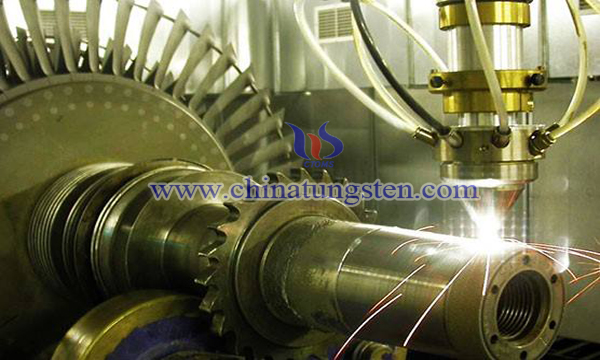Laser Cladding Technology for Nickel Tungsten Coating
- Details
- Category: Tungsten Information
- Published on Saturday, 28 April 2018 16:25
Surface coating technology has become the most efficient implementation plan for drilling equipment. Tungsten carbide is one of the main materials of the surface coating technology. Most of the commonly used materials are nickel based tungsten carbide alloy powder, of which tungsten carbide is hard phase, it plays the role of wear resistance, nickel alloy is bonded phase and plays the role of bonded tungsten carbide. There are many coating techniques. Laser cladding and equal transfer arc surfacing are two commonly used coatings. A laser cladding technology is listed below. The process includes:

(1) The metal samples to be coated are sandblasting to remove impurities such as oxide scale and oil dirt on the surface of the specimen.
(2) Using a laser or plasma transfer arc as a heat source, the powder feeder is blown to the central position of the laser spot or arc, and the high temperature produced by the laser or plasma transfer arc rapidly heat the powder and matrix surface and melt, mix and diffuse together, with the relative movement of the light spot or arc with the workpiece. After the heat source has left, the liquid alloy solidified gradually forming a high performance alloy coating, thus strengthening and hardening the workpiece surface.
(3) Proper preparation of the coating is carried out by sandblasting or grinding to remove a small amount of oxide slag and unmelted powder on the surface.
The nickel based tungsten carbide powder contains spherical tungsten carbide particles coated with nickel metal Nickel thickness of 5~10μm. The spherical tungsten carbide particle is composed of tungsten carbide and carbonized two tungsten, and has a layer of feathery eutectic structure, and its diameter is 40~130μm.
The advantages of laser cladding are that the energy density is large, the heating is concentrated, the penetration ability is strong, the coating can be prepared at high speed and the productivity is high. Because of its small thermal influence on the matrix and low dilution rate, the workpiece has small deformation and controllable process. Moreover, the microstructure of the coating is compact and the microdefects are few. The coating is metallurgical bonding with the substrate and has high strength.
- Tungsten Manufacturer & Supplier, Chinatungsten Online: www.chinatungsten.com
- Tungsten News & Prices of China Tungsten Industry Association: www.ctia.com.cn
- Molybdenum News & Price: news.molybdenum.com.cn
- Tel.: 86 592 5129696; Fax: 86 592 5129797; Email: sales@chinatungsten.com



 sales@chinatungsten.com
sales@chinatungsten.com